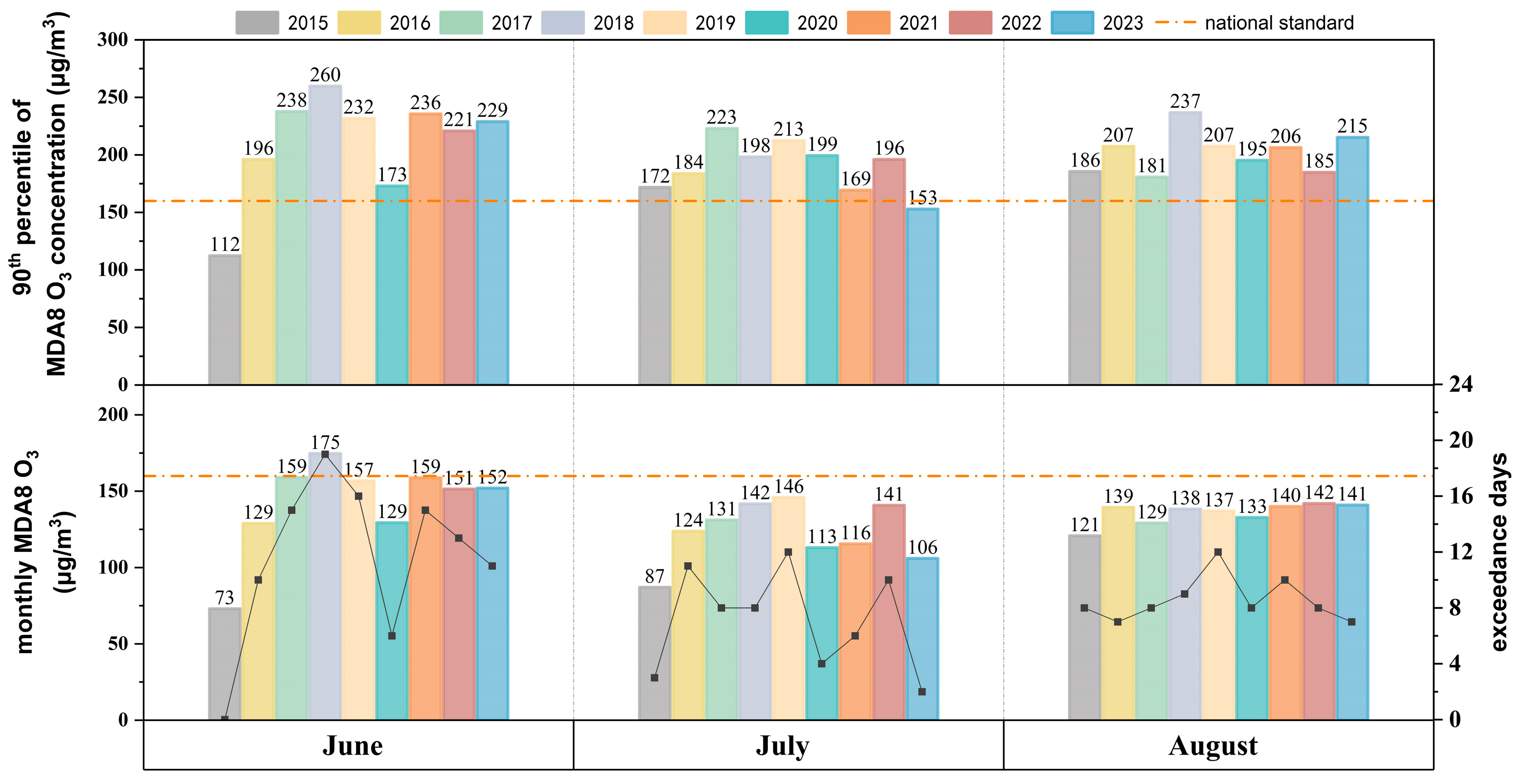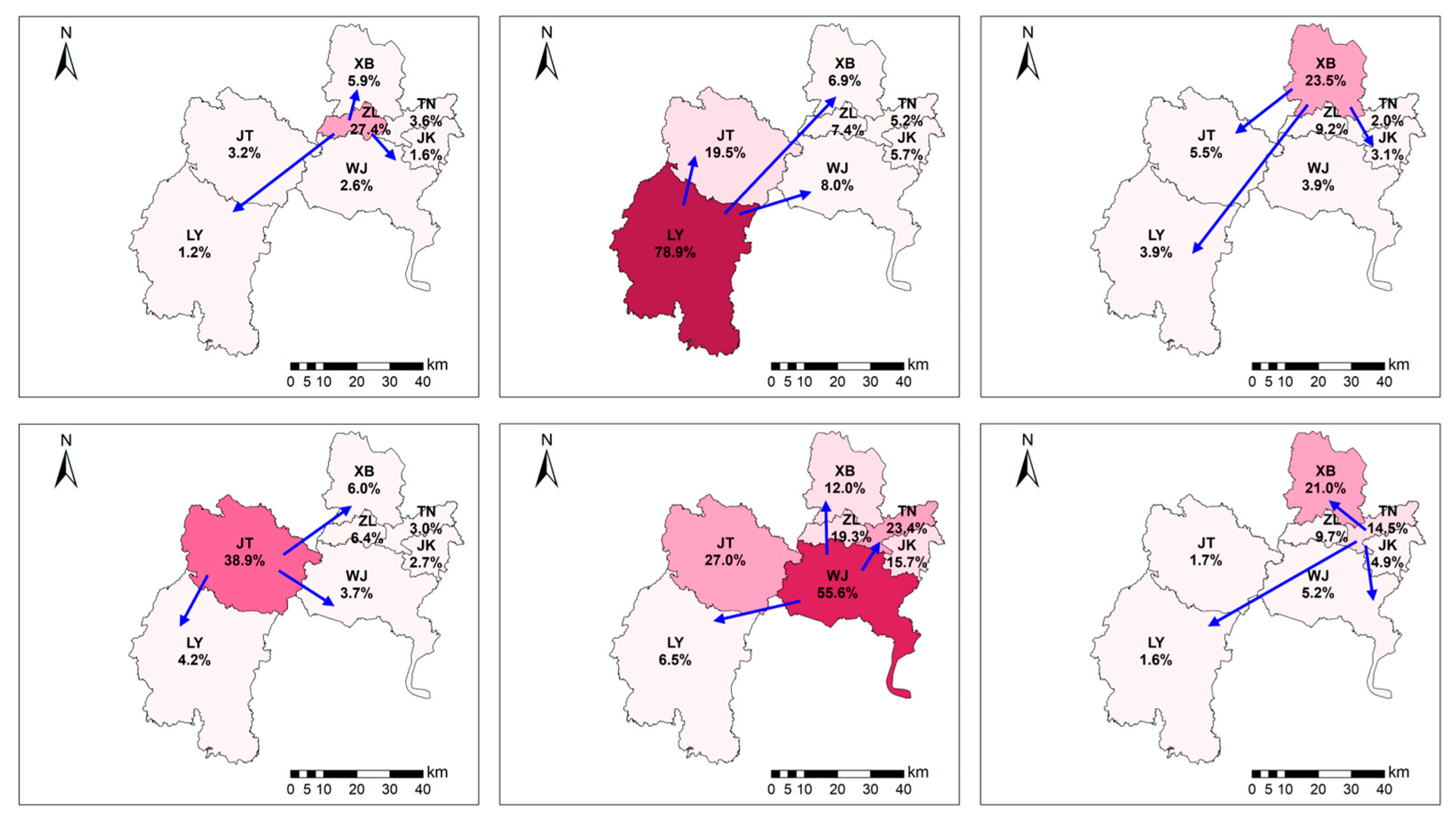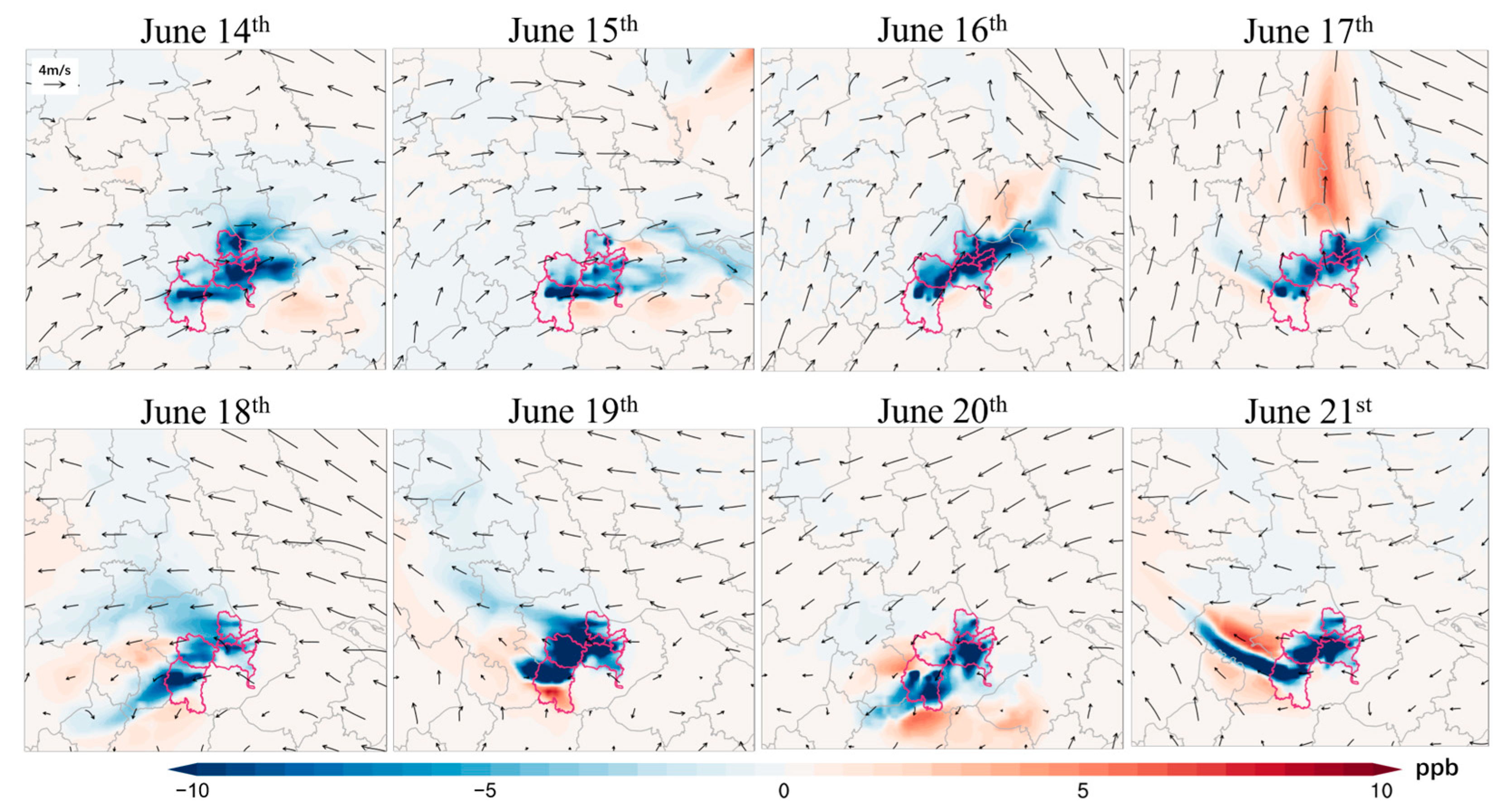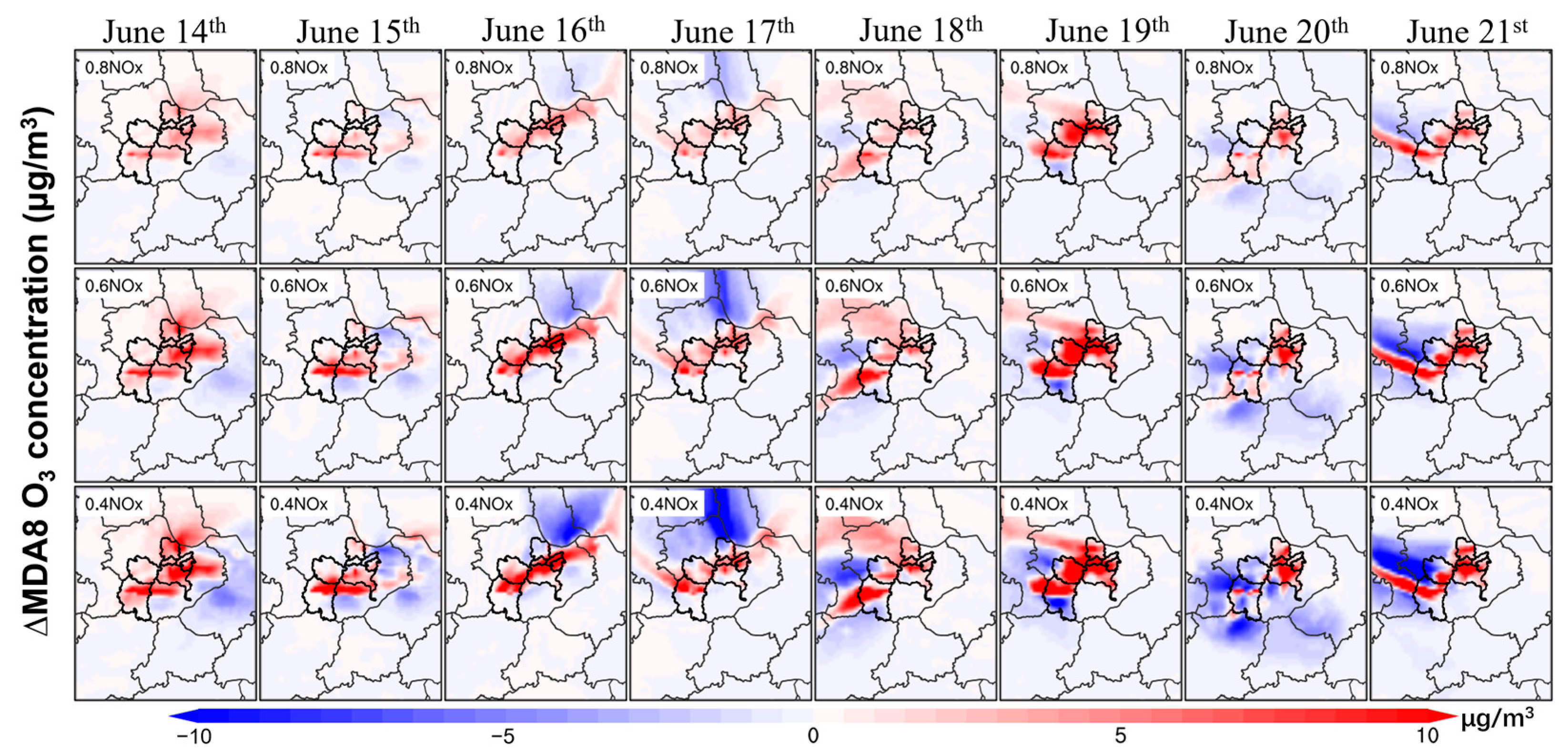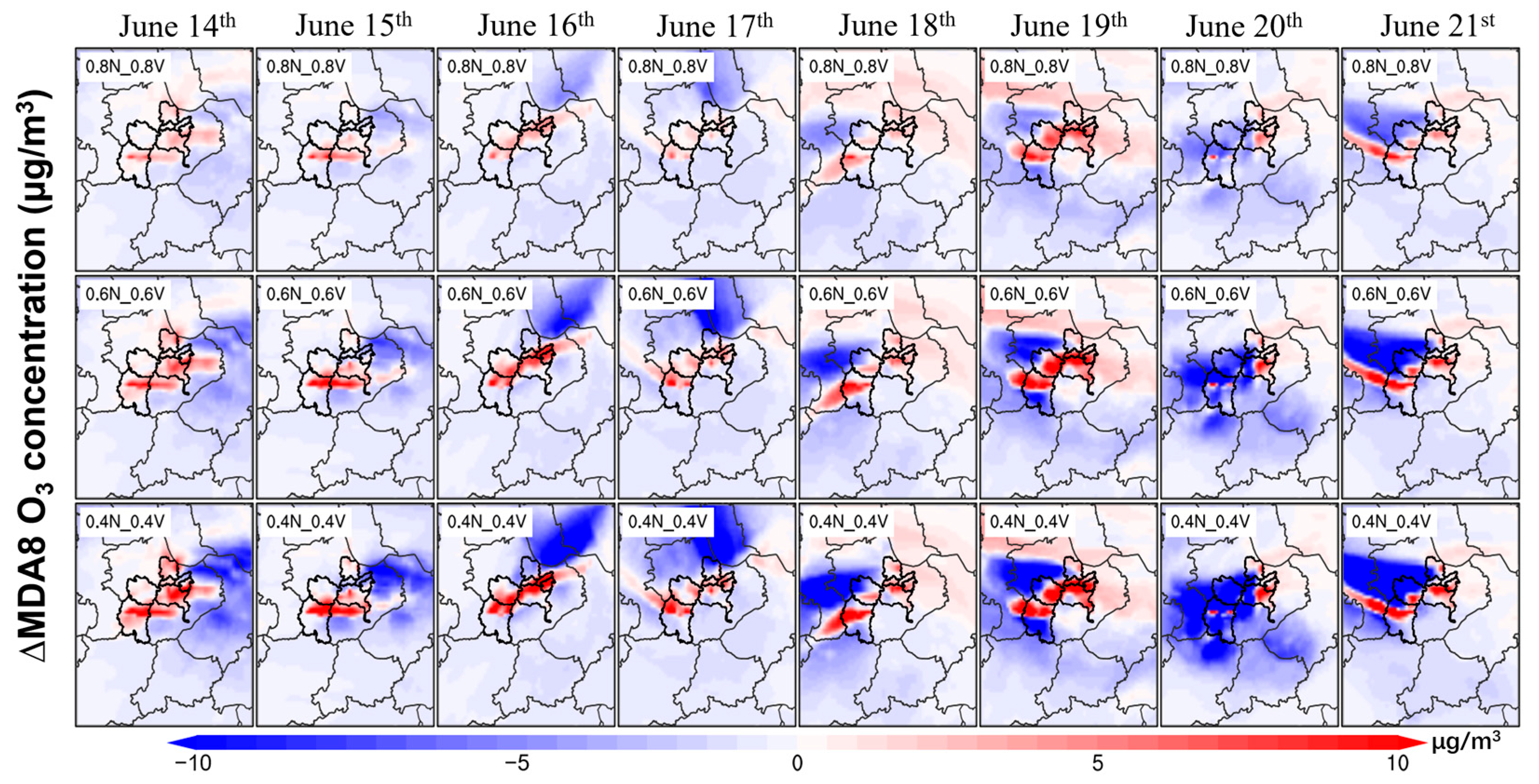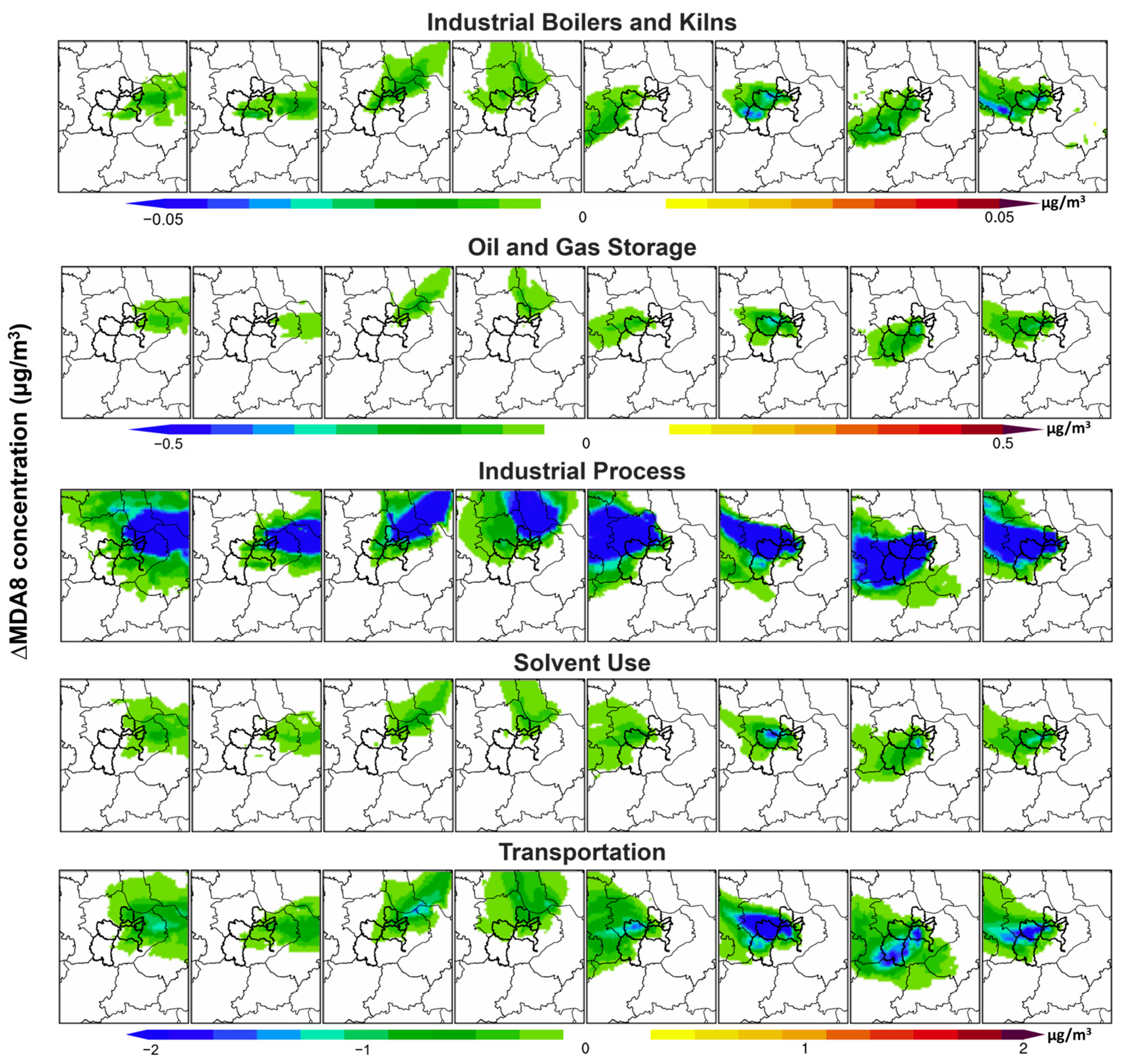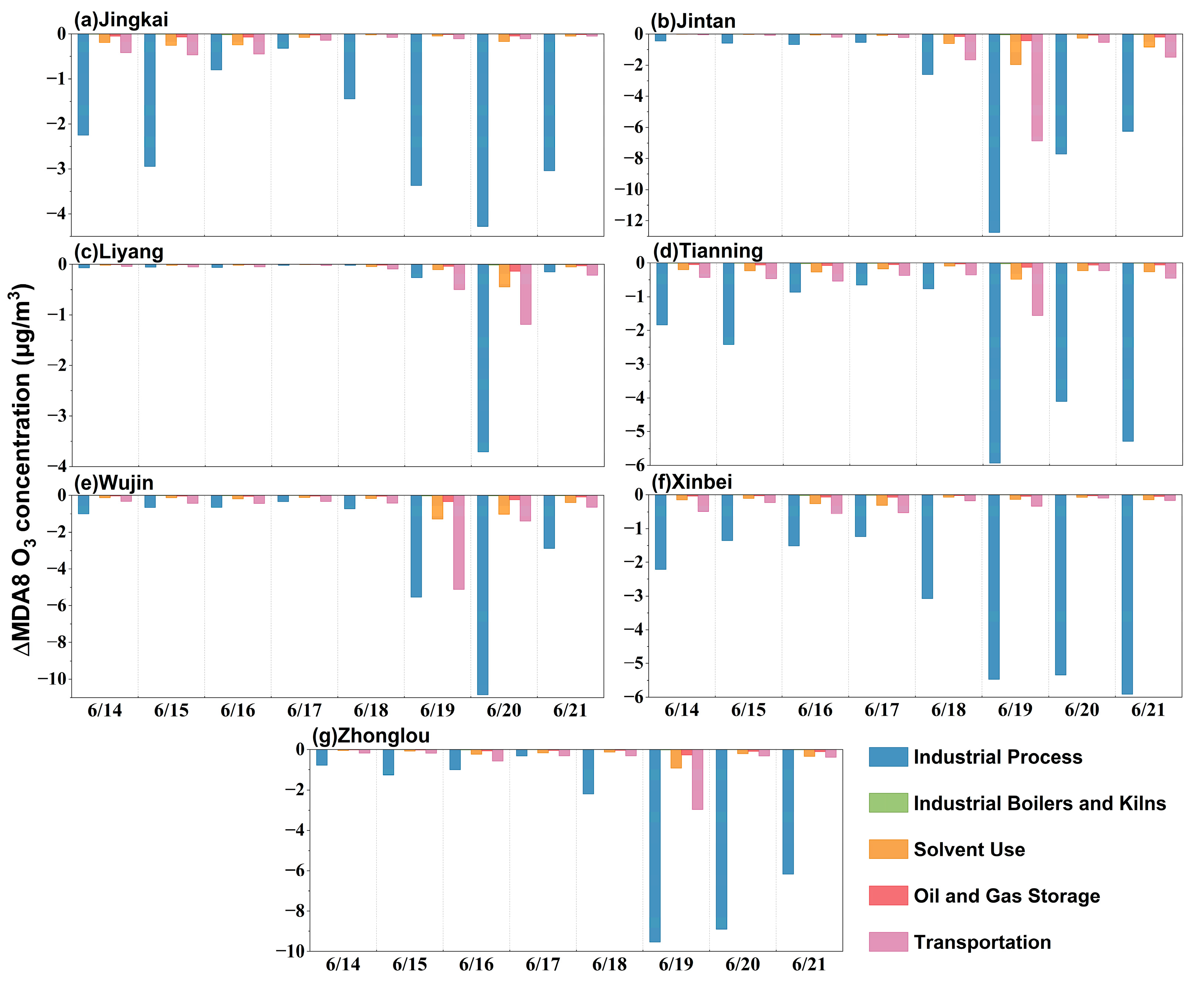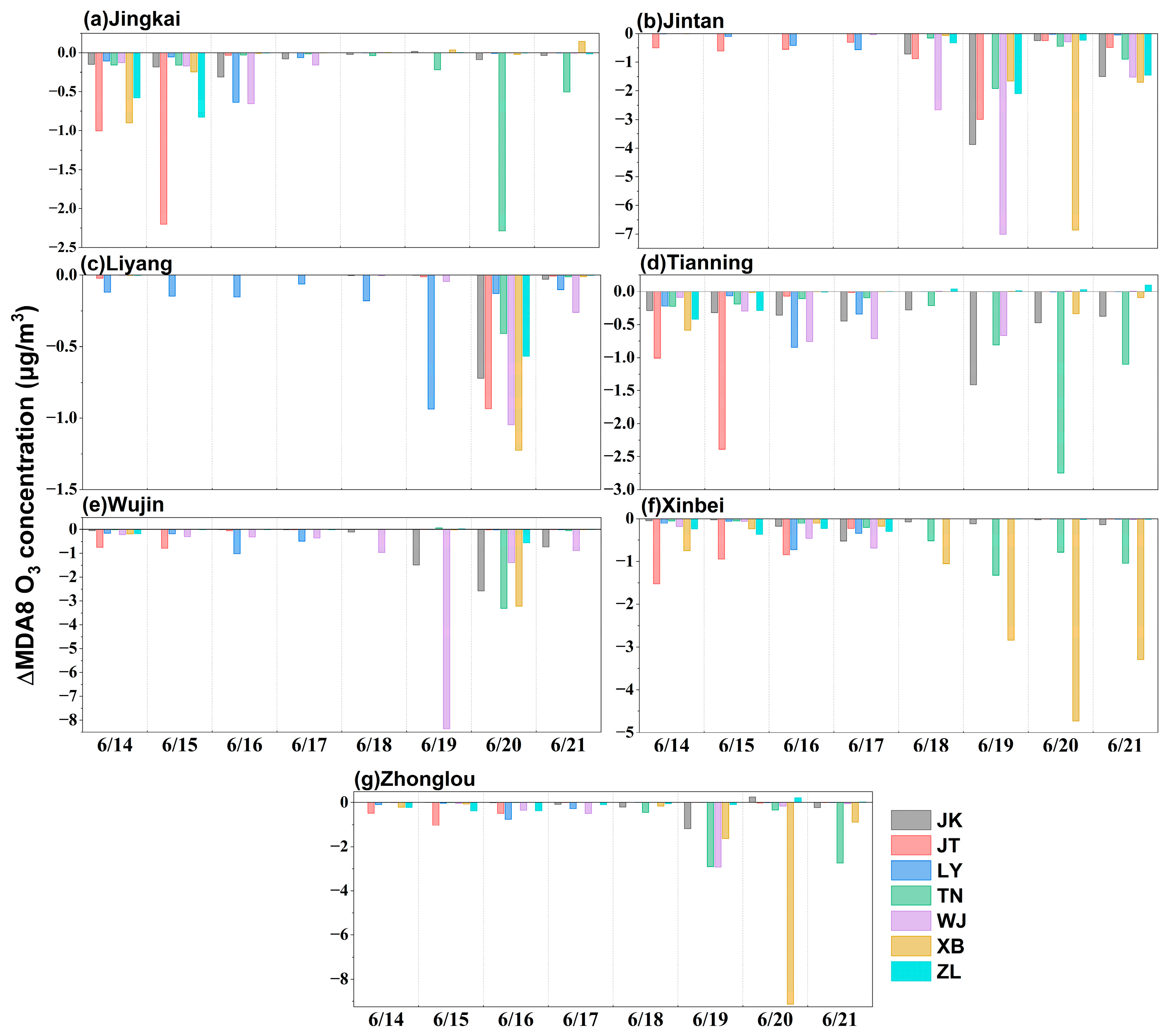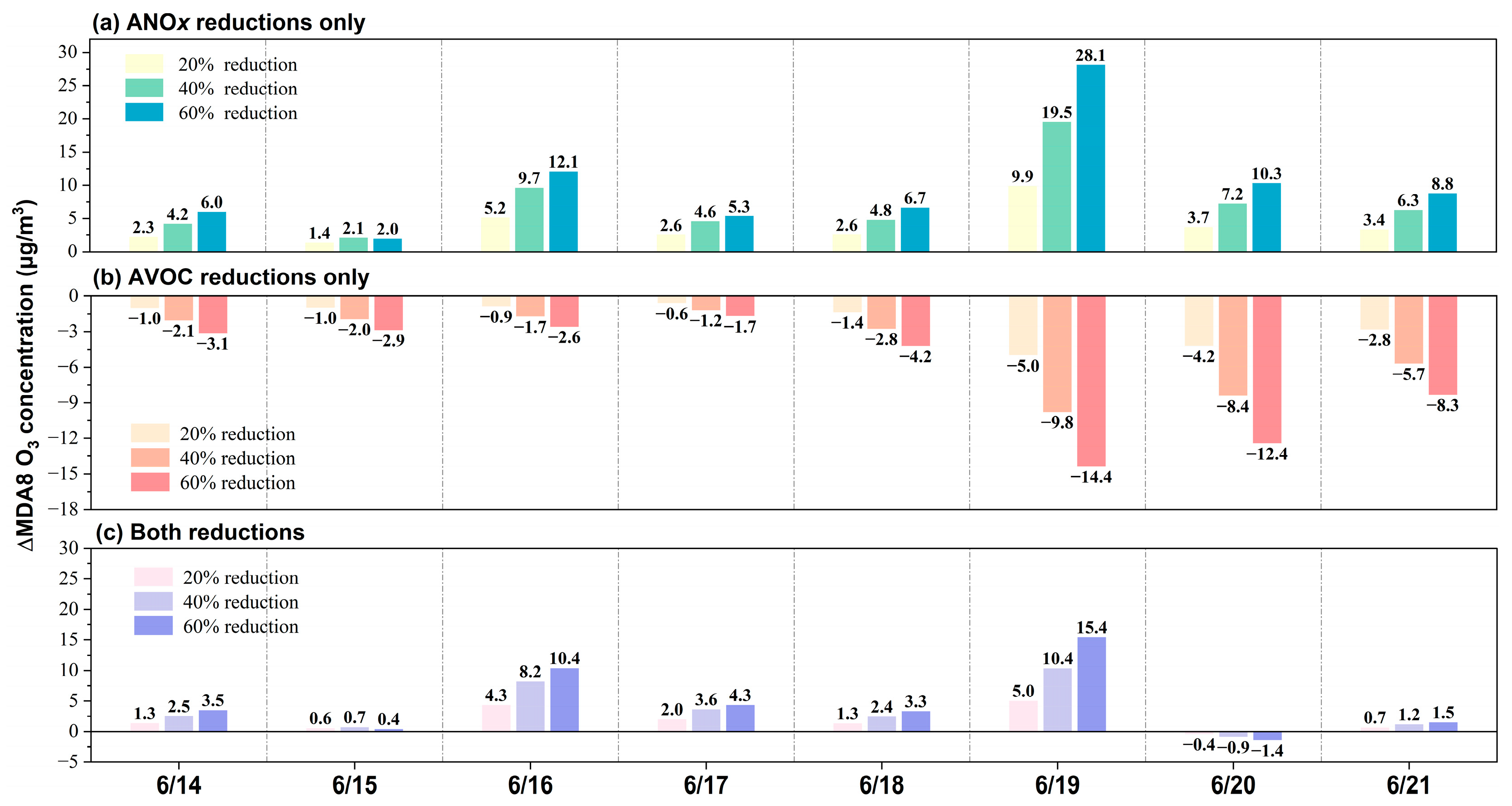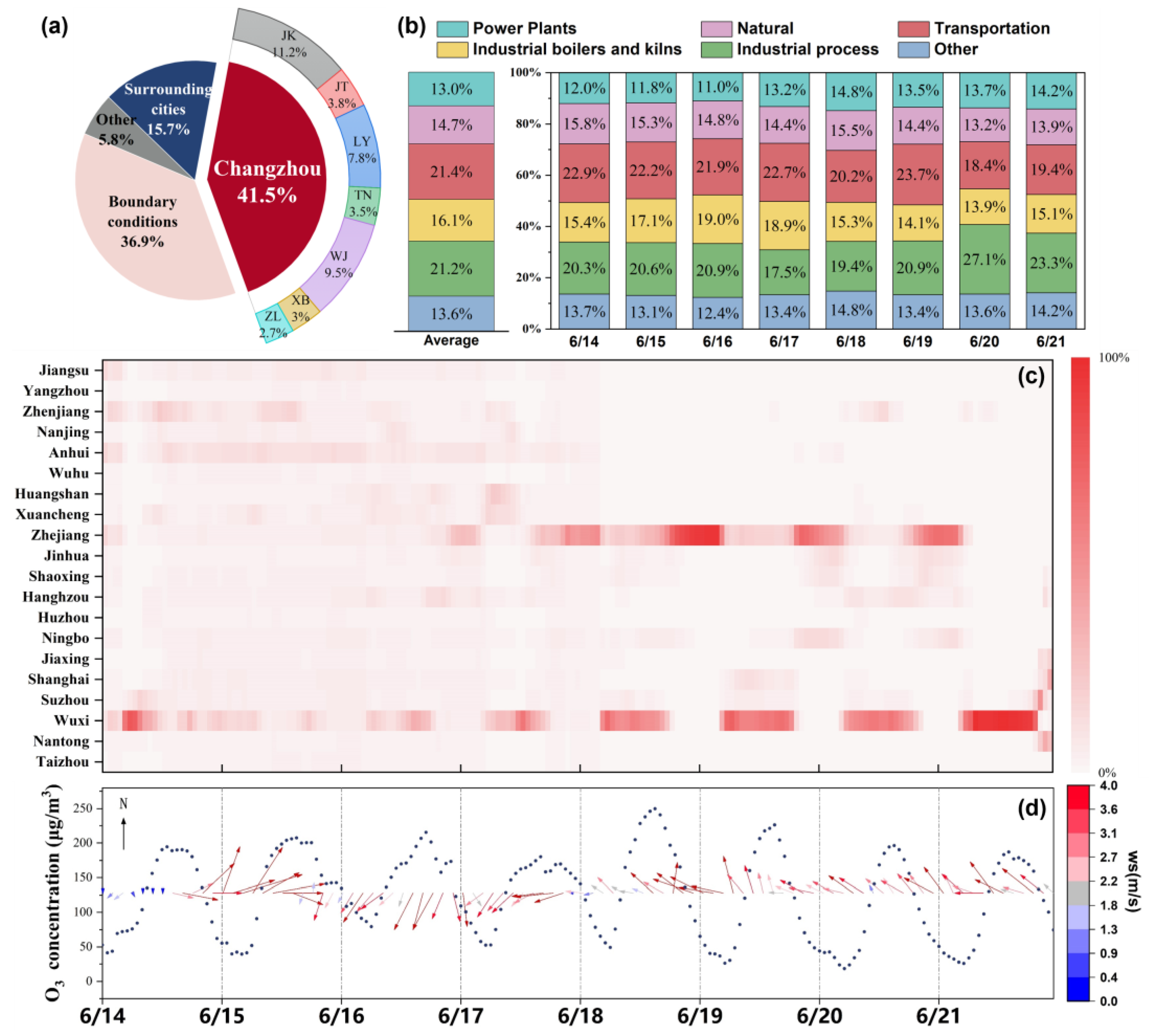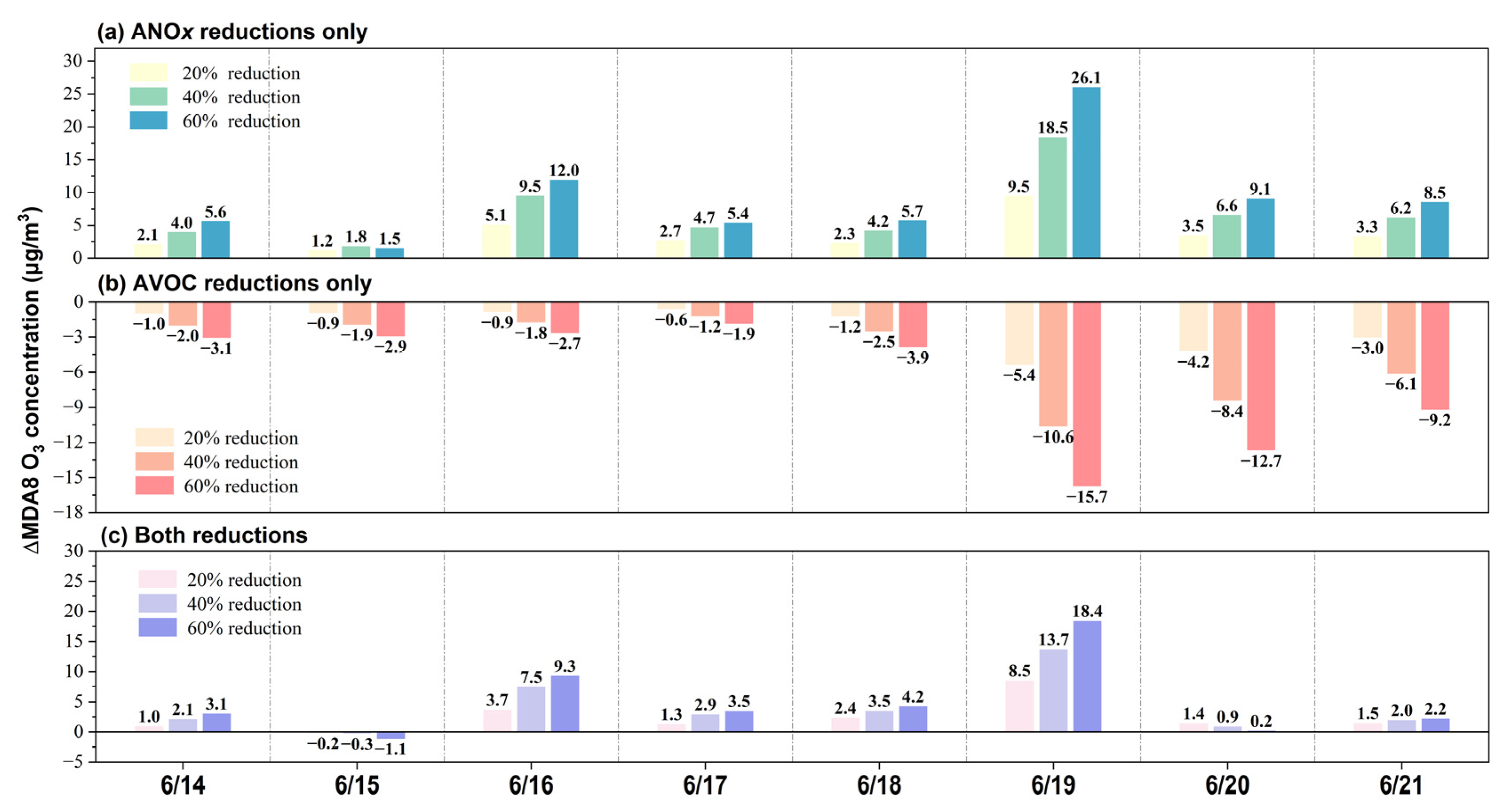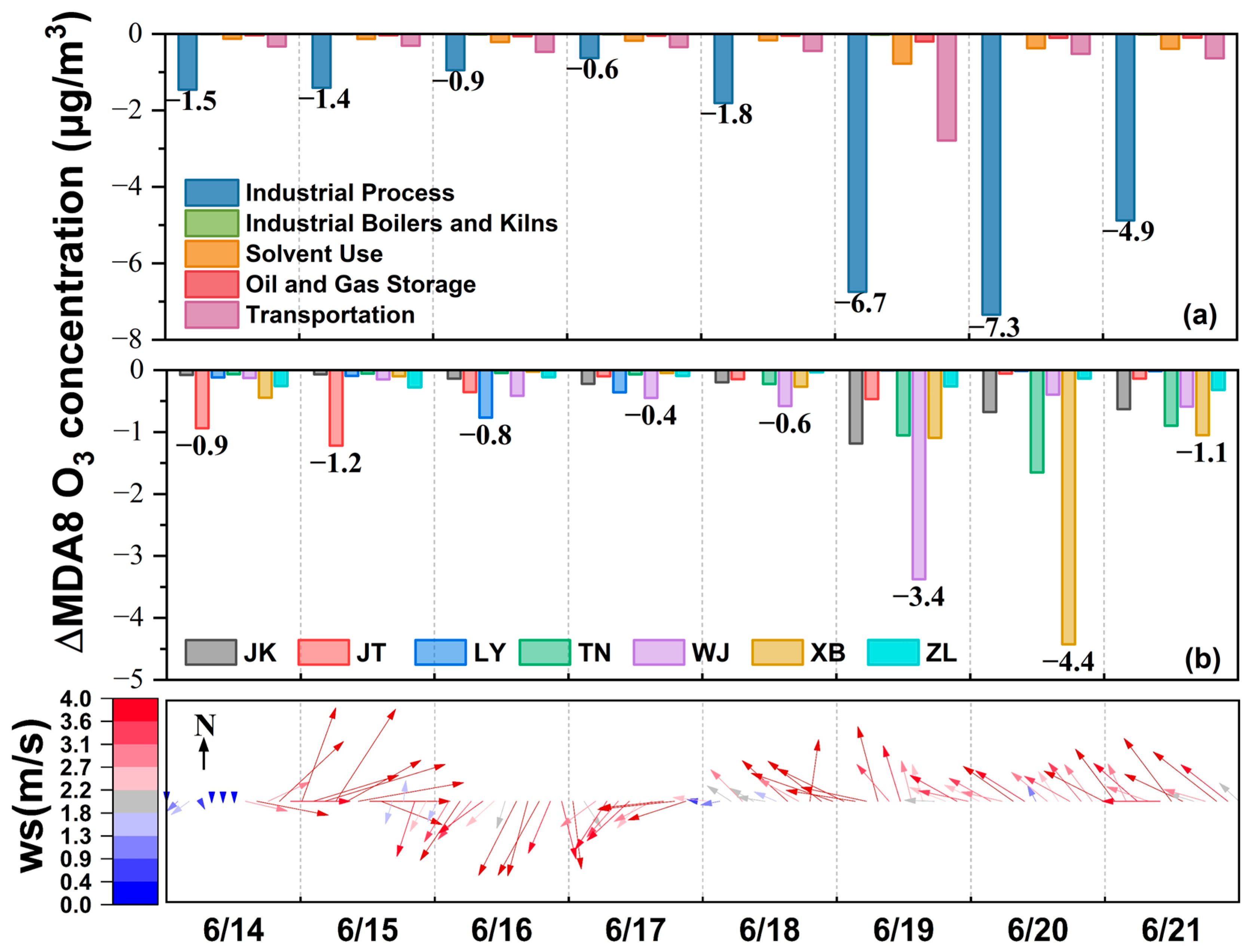Appendix A
Table A1.
Information of national and provincial monitoring stations in Changzhou.
Table A1.
Information of national and provincial monitoring stations in Changzhou.
| County Name | Station Name | Longitude/(°) | Latitude/(°) |
|---|
| LY | YSZZ | 119.478 | 31.402 |
| DMZZ | 119.489 | 31.443 |
| WJ | WJJC | 119.946 | 31.706 |
| WJJF | 119.871 | 31.711 |
| JT | JTCQ | 119.594 | 31.728 |
| JTJZJG | 119.593 | 31.739 |
| JTJC | 119.602 | 31.758 |
| TN | SJC | 119.963 | 31.762 |
| JK | JKQ | 120.055 | 31.776 |
| ZL | ZL | 119.903 | 31.793 |
| XZZX | 119.982 | 31.817 |
| XB | AJ | 119.923 | 31.908 |
Table A2.
Details of uniform reduction scenarios.
Table A2.
Details of uniform reduction scenarios.
| Emission Reduction Scenarios | Local Area of Changzhou | Surrounding Area |
|---|
| Emission Ratio of AVOCs | Emission Ratio of NOx | Emission Ratio of AVOCs | Emission Ratio of NOx |
|---|
| BASE | 100% | 100% | 100% | 100% |
| Scen 1 | 100% | 100% | 80% | 80% |
| Case 1 | 100% | 80% | 80% | 80% |
| Case 2 | 100% | 60% | 80% | 80% |
| Case 3 | 100% | 40% | 80% | 80% |
| Case 4 | 80% | 100% | 80% | 80% |
| Case 5 | 60% | 100% | 80% | 80% |
| Case 6 | 40% | 100% | 80% | 80% |
| Case 7 | 80% | 80% | 80% | 80% |
| Case 8 | 60% | 60% | 80% | 80% |
| Case 9 | 40% | 40% | 80% | 80% |
Table A3.
Details of sector-specific reduction scenarios.
Table A3.
Details of sector-specific reduction scenarios.
| Emission Reduction Scenarios | Local Area of Changzhou | Surrounding Area |
|---|
| Source Category | Emission Ratio of AVOC | Emission Ratio of ANOx | Emission Ratio of AVOC | Emission Ratio of ANOx |
|---|
| Case 10 | Industrial Process | 60% | 100% | 80% | 80% |
| Case 11 | Industrial Boilers and Kilns | 60% | 100% | 80% | 80% |
| Case 12 | Solvent Use | 60% | 100% | 80% | 80% |
| Case 13 | Oil and Gas Storage | 60% | 100% | 80% | 80% |
| Case 14 | Transportation | 60% | 100% | 80% | 80% |
Table A4.
Details of county-specific reduction scenarios.
Table A4.
Details of county-specific reduction scenarios.
| Emission Reduction Scenarios | Local Area of Changzhou | Surrounding Area |
|---|
| County Name | Emission Ratio of AVOC | Emission Ratio of ANOx | Emission Ratio of AVOC | Emission Ratio of ANOx |
|---|
| Case 15 | JK | 60% | 100% | 80% | 80% |
| Case 16 | JT | 60% | 100% | 80% | 80% |
| Case 17 | LY | 60% | 100% | 80% | 80% |
| Case 18 | TN | 60% | 100% | 80% | 80% |
| Case 19 | WJ | 60% | 100% | 80% | 80% |
| Case 20 | XB | 60% | 100% | 80% | 80% |
| Case 21 | ZL | 60% | 100% | 80% | 80% |
Table A5.
Definition of model performance evaluation metrics used in this study.
Table A5.
Definition of model performance evaluation metrics used in this study.
| No. | Statistics Index | Definition |
|---|
| 1 | Mean bias (MB) | |
| 2 | Normalized mean bias (NMB) | |
| 3 | Correlation coefficient (R) | |
| 4 | Index of agreement (IOA) | |
In the formula, represents the number of matches between the simulated values of meteorological factors or pollutants involved in the evaluation and the observed values. and denote the simulated values and corresponding observed values at time , respectively. and are the average values of the simulated values and observed values of meteorological factors or pollutants, respectively.
Table A6.
Model performance evaluation of WRF-simulated 2 m temperature (T2), 10 m wind speed (WS10), and relative humidity (RH).
Table A6.
Model performance evaluation of WRF-simulated 2 m temperature (T2), 10 m wind speed (WS10), and relative humidity (RH).
| City | Meteorological Parameters | Observation | Simulation | MB | NMB | R | IOA |
|---|
| Changzhou | T2 (°C) | 28.0 | 27.8 | −0.1 | −0.4% | 0.8 | 0.9 |
| WS10 (m/s) | 3.4 | 3.7 | 0.4 | 10.7% | 0.4 | 0.6 |
| RH (%) | 66.3 | 64.0 | −2.4 | −3.6% | 0.8 | 0.9 |
| Hangzhou | T2 (°C) | 26.9 | 27.7 | 0.8 | 3.0% | 0.8 | 0.9 |
| WS10 (m/s) | 2.8 | 3.1 | 0.3 | 12.0% | 0.4 | 0.6 |
| RH (%) | 77.9 | 66.7 | −11.1 | −14.0% | 0.8 | 0.8 |
| Shanghai | T2 (°C) | 26.6 | 26.1 | −0.5 | -2.0% | 0.9 | 0.9 |
| WS10 (m/s) | 3.7 | 3.8 | 0.1 | 2.0% | 0.4 | 0.7 |
| RH (%) | 78.6 | 72.3 | −6.2 | −8.0% | 0.8 | 0.9 |
| Nanjing | T2 (°C) | 27.7 | 28.7 | 1.0 | 4.0% | 0.8 | 0.9 |
| WS10 (m/s) | 3.8 | 3.9 | 0.1 | 2.0% | 0.5 | 0.7 |
| RH (%) | 66.4 | 59.6 | −6.8 | −10.0% | 0.8 | 0.8 |
| Hefei | T2 (°C) | 28.0 | 28.4 | 0.4 | 1.0% | 0.8 | 0.9 |
| WS10 (m/s) | 3.6 | 4.0 | 0.4 | 11.0% | 0.4 | 0.6 |
| RH (%) | 70.5 | 64.7 | −5.8 | −8% | 0.8 | 0.8 |
Table A7.
Model performance evaluation for simulated MDA8 O3 in 41 cities in the YRD region during June 2022.
Table A7.
Model performance evaluation for simulated MDA8 O3 in 41 cities in the YRD region during June 2022.
| City Name | Observation (µg·m−3) | Simulation (µg·m−3) | MB (µg·m−3) | NMB (%) | RMSE | R | IOA |
|---|
| Hangzhou | 129.5 | 117.2 | −12.3 | −9.5 | 39.0 | 0.7 | 0.8 |
| Huzhou | 139.6 | 129.3 | −10.3 | −7.4 | 39.5 | 0.6 | 0.7 |
| Jiaxing | 137.7 | 136.9 | −0.8 | −0.6 | 39.4 | 0.5 | 0.7 |
| Jinhua | 108.9 | 101.3 | −7.6 | −7 | 34.1 | 0.8 | 0.8 |
| Lishui | 101.6 | 71.0 | −30.6 | −30.1 | 38.4 | 0.7 | 0.7 |
| Ningbo | 102.4 | 99.3 | −3.1 | −3 | 38.7 | 0.5 | 0.7 |
| Quzhou | 100.0 | 89.4 | −10.6 | −10.6 | 27.3 | 0.8 | 0.8 |
| Shaoxing | 123.0 | 111.3 | −1.7 | −9.5 | 35.1 | 0.7 | 0.8 |
| Taizhou (Zhejiang) | 96.2 | 91.2 | −5.0 | −5.2 | 30.1 | 0.7 | 0.8 |
| Wenzhou | 99.2 | 89.6 | −9.6 | −9.3 | 33.2 | 0.7 | 0.8 |
| Zhoushan | 73.4 | 80.3 | 7.0 | 9.5 | 28.0 | 0.5 | 0.7 |
| Shanghai | 121.5 | 121.8 | 0.3 | 0.3 | 37.5 | 0.6 | 0.7 |
| Changzhou | 134.8 | 148.3 | 13.6 | 10.1 | 46.5 | 0.5 | 0.6 |
| Huai’an | 128.2 | 150.3 | 22.1 | 17.3 | 47.8 | 0.4 | 0.6 |
| Lianyungang | 122.4 | 144.7 | 22.3 | 18.2 | 38.9 | 0.7 | 0.8 |
| Nanjing | 143.2 | 141.2 | −2.0 | −1.4 | 43.0 | 0.5 | 0.7 |
| Nantong | 117.9 | 141.8 | 24.0 | 20.3 | 47.8 | 0.6 | 0.8 |
| Suqian | 142.0 | 159.9 | 17.9 | 12.6 | 41.7 | 0.5 | 0.7 |
| Suzhou (Jiangsu) | 137.7 | 136.6 | −1.1 | −0.8 | 38.9 | 0.6 | 0.8 |
| Taizhou (Jiangsu) | 131.5 | 135.7 | 4.2 | 3.2 | 46.6 | 0.4 | 0.6 |
| Wuxi | 134.8 | 145.7 | 10.9 | 8.1 | 40.6 | 0.6 | 0.8 |
| Xuzhou | 147.4 | 168.4 | 21.0 | 14.2 | 50 | 0.3 | 0.5 |
| Yancheng | 121.1 | 148.1 | 27.0 | 22.3 | 49.6 | 0.6 | 0.7 |
| Yangzhou | 140.9 | 151.5 | 10.5 | 7.5 | 52.7 | 0.4 | 0.6 |
| Zhenjiang | 138.5 | 151.9 | 13.4 | 9.7 | 49.4 | 0.5 | 0.7 |
| Anqing | 115.0 | 105.2 | −9.8 | −8.5 | 37.5 | 0.6 | 0.7 |
| Bozhou | 145.4 | 164.1 | 18.7 | 12.8 | 50.1 | 0.1 | 0.4 |
| Chizhou | 118.5 | 104.0 | −13.5 | −11.4 | 35.4 | 0.7 | 0.8 |
| Chuzhou | 145.9 | 148.7 | 2.8 | 1.9 | 40.9 | 0.6 | 0.7 |
| Fuyang | 142.8 | 146.1 | 3.3 | 2.3 | 47.0 | 0.2 | 0.5 |
| Hefei | 132.5 | 127.0 | −5.5 | −4.1 | 37.0 | 0.3 | 0.6 |
| Huaibei | 147.0 | 157.1 | 10.1 | 6.9 | 45.0 | 0.2 | 0.5 |
| Huangshan | 102.5 | 82.8 | −19.7 | −19.2 | 29.2 | 0.8 | 0.7 |
| Lu’an | 128.6 | 122.7 | −5.8 | −4.5 | 41.2 | 0.3 | 0.6 |
| Ma’anshan | 140.1 | 139.1 | −1.0 | −0.7 | 37.6 | 0.5 | 0.7 |
| Suzhou (Anhui) | 141.2 | 152.6 | 11.4 | 8.1 | 42.9 | 0.3 | 0.6 |
| Tongling | 109.0 | 105.3 | −3.7 | −3.4 | 34.4 | 0.6 | 0.8 |
| Wuhu | 124.6 | 121.1 | −3.5 | −2.8 | 32.9 | 0.6 | 0.8 |
| Xuancheng | 118.6 | 92.9 | −25.6 | −21.6 | 36.7 | 0.7 | 0.7 |
| Bengbu | 146.9 | 154.0 | 7.2 | 4.9 | 42.1 | 0.3 | 0.6 |
| Huainan | 140.6 | 139.7 | −1.0 | −0.7 | 40.5 | 0.2 | 0.6 |
Table A8.
Parameter settings for the WRF and CMAQ models.
Table A8.
Parameter settings for the WRF and CMAQ models.
| Simulation Region |
| Horizontal resolution | 36 km, 12 km, and 4 km |
| Center longitude and latitude | 34° N, 110° E |
| Projection method | Lambert conformal conic |
| WRF |
| Microphysical process | Purdue–Lin |
| Land surface process | Noah land surface model |
| Planetary boundary layer scheme | Yonsei University |
| Long-wave radiation | RRTM |
| Short-wave radiation | Goddard |
| Cumulus convection scheme | Kain–Fritsch |
| CMAQ |
| Gas-phase chemical mechanism | CB6 |
| Aerosol module | AERO7 |
| Initial/boundary conditions | CMAQ default profile |
Figure A1.
Monthly average of maximum eight-hour ozone (MDA8) concentrations and exceedance days of MDA8 in Changzhou from June to August, 2015 to 2023. The orange dashed lines represents the O3 limits for light and moderate pollution levels, respectively, according to the Ambient Air Quality Standards.
Figure A1.
Monthly average of maximum eight-hour ozone (MDA8) concentrations and exceedance days of MDA8 in Changzhou from June to August, 2015 to 2023. The orange dashed lines represents the O3 limits for light and moderate pollution levels, respectively, according to the Ambient Air Quality Standards.
Figure A2.
(a) Regional and (b) sectoral contributions of MDA8 O3 in June 2022.
Figure A2.
(a) Regional and (b) sectoral contributions of MDA8 O3 in June 2022.
Figure A3.
Spatial distribution of relative MDA8 ozone contributions between counties when one region was an ozone receptor in June 2022.
Figure A3.
Spatial distribution of relative MDA8 ozone contributions between counties when one region was an ozone receptor in June 2022.
Figure A4.
Spatial distribution of relative MDA8 ozone contributions between counties when one region was an ozone source in June 2022.
Figure A4.
Spatial distribution of relative MDA8 ozone contributions between counties when one region was an ozone source in June 2022.
Figure A5.
Spatial distribution of local ozone sensitivity coefficient to NOx based on CMAQ-DDM simulation. (The highlighted red area represents Changzhou).
Figure A5.
Spatial distribution of local ozone sensitivity coefficient to NOx based on CMAQ-DDM simulation. (The highlighted red area represents Changzhou).
Figure A6.
Spatial distribution of local ozone sensitivity coefficient to VOC based on CMAQ-DDM simulation. (The area outlined in blue represents Changzhou).
Figure A6.
Spatial distribution of local ozone sensitivity coefficient to VOC based on CMAQ-DDM simulation. (The area outlined in blue represents Changzhou).
Figure A7.
Spatial variation in daily MDA8 O3 concentrations under the solo reduction of 20%, 40%, and 60% ANOx emissions in Changzhou from 14 to 21 June 2022. (The area outlined represents Changzhou).
Figure A7.
Spatial variation in daily MDA8 O3 concentrations under the solo reduction of 20%, 40%, and 60% ANOx emissions in Changzhou from 14 to 21 June 2022. (The area outlined represents Changzhou).
Figure A8.
Spatial variation in daily MDA8 O3 concentrations under the solo reduction of 20%, 40%, and 60% AVOC emissions in Changzhou from 14 to 21 June 2022. (The area outlined represents Changzhou).
Figure A8.
Spatial variation in daily MDA8 O3 concentrations under the solo reduction of 20%, 40%, and 60% AVOC emissions in Changzhou from 14 to 21 June 2022. (The area outlined represents Changzhou).
Figure A9.
Spatial variation in daily MDA8 O3 concentrations under the reduction of 20%, 40%, and 60% ANOx and AVOC emissions in Changzhou from 14 to 21 June 2022. (The area outlined represents Changzhou).
Figure A9.
Spatial variation in daily MDA8 O3 concentrations under the reduction of 20%, 40%, and 60% ANOx and AVOC emissions in Changzhou from 14 to 21 June 2022. (The area outlined represents Changzhou).
Figure A10.
Spatial variation in daily MDA8 O3 concentrations under the sector-specific emission reduction in Changzhou from 14 to 21 June 2022. (The area outlined represents Changzhou).
Figure A10.
Spatial variation in daily MDA8 O3 concentrations under the sector-specific emission reduction in Changzhou from 14 to 21 June 2022. (The area outlined represents Changzhou).
Figure A11.
Spatial variation in daily MDA8 O3 concentrations under the county-specific emission reduction in Changzhou from 14 to 21 June 2022. (The area outlined represents Changzhou. The area outlined in red represents the county that implemented emission reduction).
Figure A11.
Spatial variation in daily MDA8 O3 concentrations under the county-specific emission reduction in Changzhou from 14 to 21 June 2022. (The area outlined represents Changzhou. The area outlined in red represents the county that implemented emission reduction).
Figure A12.
MDA8 O3 concentrations changes in seven counties under sector-specific emission reduction scenarios from 14 to 21 June 2022.
Figure A12.
MDA8 O3 concentrations changes in seven counties under sector-specific emission reduction scenarios from 14 to 21 June 2022.
Figure A13.
MDA8 O3 concentrations changes in seven counties under county-specific emission reduction scenarios from 14 to 21 June 2022.
Figure A13.
MDA8 O3 concentrations changes in seven counties under county-specific emission reduction scenarios from 14 to 21 June 2022.
Figure A14.
Changes in averaged MDA8 ozone concentrations in Changzhou from 14 to 21 June 2022 under uniform emission reduction scenarios. (The AVOC and NOx emissions in the surrounding area are 100%).
Figure A14.
Changes in averaged MDA8 ozone concentrations in Changzhou from 14 to 21 June 2022 under uniform emission reduction scenarios. (The AVOC and NOx emissions in the surrounding area are 100%).
Figure A15.
Changes in MDA8 O3 concentrations with (a) ANOx reduction only, (b) AVOC reduction only, and (c) both reductions in Changzhou from 14 to 21 June 2022. (The AVOC and NOx emissions in the surrounding area are 100%).
Figure A15.
Changes in MDA8 O3 concentrations with (a) ANOx reduction only, (b) AVOC reduction only, and (c) both reductions in Changzhou from 14 to 21 June 2022. (The AVOC and NOx emissions in the surrounding area are 100%).
Figure A16.
Changes in MDA8 O3 concentrations with a 40% AVOC emissions reduction across different sectors within (a) WJ and (b) XB during 14 to 21 June 2022.
Figure A16.
Changes in MDA8 O3 concentrations with a 40% AVOC emissions reduction across different sectors within (a) WJ and (b) XB during 14 to 21 June 2022.
Figure A17.
Daily average MDA8 O3 concentrations and 14:00 Beijing time wind direction in the YRD region from 14 to 21 June 2022. (The blue box lines represent the Changzhou region).
Figure A17.
Daily average MDA8 O3 concentrations and 14:00 Beijing time wind direction in the YRD region from 14 to 21 June 2022. (The blue box lines represent the Changzhou region).
